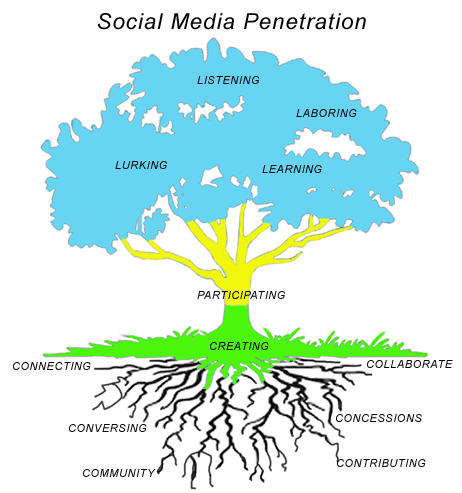If you were to look at the following image, what would you say the expanse of your social media exposure, involvement or engagement would be?

Let’s assume that we all start off as seedlings in social media, and as we learn more, we grow. As the tree grows, so does our comfort level. Eventually we branch out and we all go in different directions, yet we all come from the same seed. We all have the same background and the same foundation.
It should all start with listening, learning, lurking and laboring. Lurking? Yes, lurking. Call it passive participation, but we all have done it. We watch the conversations, wondering where we can insert ourselves into them. If we don’t we lurk, we hover if you will.
Laboring? Even passive participation takes work. It takes effort and you have to put forth effort.
As we progress and grow, we become more comfortable in our need and desire and ability to contribute to the conversations around us. It’s a natural progression. But to make the leap to creating content is a bit more longer and takes a little bit more growth.
On the surface and by the looks of the tree, it almost seems that we all should or could be part of the yellow on this tree. However even those that are most comfortable with social media right now are not part of the yellow.Yet the desired or expected outcome from participation and creation lies in the blue areas of the tree.
Yett if we look at Forrester’s Social Technographics results, surveys show that when it comes to social content 21% of online US consumers are Creators, 37% are Critics (those who react to content created by others), and 69% are Spectators, meaning that the majority of people in Forrester’s survey would find themselves more at the root level of the social media tree.
Look at Jake Mckee’s model. The 90-9-1 Principle where 90% of users are the “audience”, or lurkers. These people tend to read or observe, but don’t actively contribute.
9% of users are “editors”, sometimes modifying content or adding to an existing thread, but rarely create content from scratch. and 1% of users are “creators”, driving large amounts of the social group’s activity and driving a vast percentage of the site’s new content, threads, and activity.
If we look at it from that standpoint then the tree will be inverted, where it’s all about how “rooted” you are and how deep your social media penetration is. The deeper, more involved you are, the more rich the experience is.

So which version of the tree are you? Where do you see yourself? Should the tree be a 100 year oak or a common weed?

 teach. If you are not aware, Scott is on a tear of late with the tremendous success of the
teach. If you are not aware, Scott is on a tear of late with the tremendous success of the 







 We have all heard a lot about the
We have all heard a lot about the 
